Wednesday, February 24. 2016
Note: j'aurai le plaisir d'être en entretien --en français-- ce vendredi 26.02 à 20h avec le journaliste Frédéric Pfyffer, de la Radio Télévision Suisse Romande, dans le cadre du programme Histoire Vivante qui traite cette semaine du sujet des "Big Data".
Cet entretien, qui a été enregistré en fin de semaine passée, nous verra évoquer la façon dont les artistes ou designers abordent aujourd'hui --mais aussi un peu hier-- cette question des données. En contrepoint ou complément peut-être des approches scientifiques. Pour ma part, aussi bien dans le contexte de ma pratique indépendante (fabric | ch où de nombreux projets réalisés ou en développement s'appuient sur des données) qu'académique (projet de recherche interdisciplinaire en cours autour des "nuages"... entre autres).
À noter encore qu'au terme de la semaine d'émissions thématiques sera diffusé sur la TSR (dimanche 28.02) le documentaire Citizenfour, qui relate toute l'aventure d'Edward Snowden et du journaliste Glenn Greenwald.
Ces cinq émissions seront également disponibles en mode podcast à la même adresse, suite à la diffusion de cette semaine.
Via RTS
-----

Une semaine d’Histoire Vivante consacrée à l’histoire de la recherche scientifique à la lumière de l’émergence de l’internet et des big data.
-
Dimanche 28 février 2016, vous pouvez découvrir sur RTS Deux: CitizenFour, un documentaire de Laura Poitras (Allemagne-USA/2014):
"Citizenfour est le pseudonyme utilisé par Edward Snowden pour contacter la réalisatrice de ce documentaire lorsqu'il décide de révéler les méthodes de surveillance de la NSA. Accompagnée d'un journaliste d'investigation, elle le rejoint dans une chambre d'hôtel à Hong Kong. La suite est un huis-clos digne des meilleurs thrillers."
Thursday, January 28. 2016
Note: I'll move this afternoon to Grandhotel Giessbach (sounds like a Wes Anderson movie) to present later tonight the temporary results of the research I'm jointly leading with Nicolas Nova for ECAL & HEAD - Genève, in partnership with EPFL-ECAL Lab & EPFL: Inhabiting and Interfacing the Cloud(s). Looking forward to meet the Swiss design research community (mainly) at the hotel...
Via iiclouds.org
-----
Christophe Guignard and myself will have the pleasure to present the temporary results of the design research Inhabiting & Interfacing the Cloud(s) next Thursday (28.01.2016) at the Swiss Design Network conference.
The conference will happen at Grandhotel Giessbach over the lake Brienz, where we'll focus on the research process fully articulated around the practice of design (with the participation of students in the case of I&IC) and the process of project.
This will apparently happen between "dinner" and "bar", as we'll present a "Fireside Talk" at 9pm. Can't wait to do and see that...
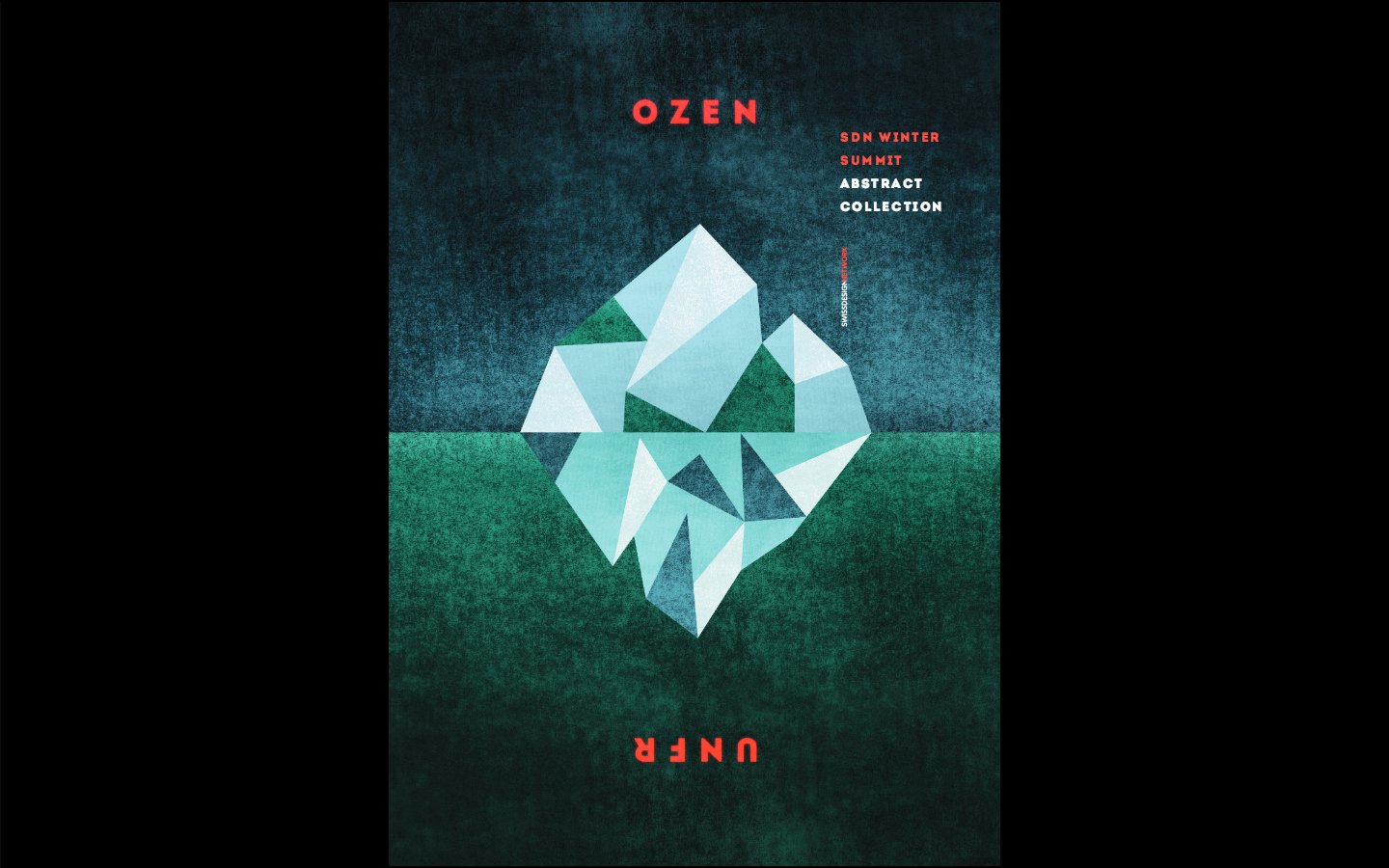

The full program and proceedings (pdf) of the conference can be accessed HERE.
As for previous events, we'll try to make a short "follow up" on this documentary blog after the event.
Friday, October 02. 2015
Via iiclouds.org
-----
The design research Inhabiting and Interfacing the Cloud(s) will be presented during the peer reviewed Renewable Futures Conference next week in Riga (Estonia), which will be the first edition of a serie that promiss to scout for radical approaches.
Christophe Guignard will introduce the participants to the stakes and the progresses of our ongoing experimental work. There will be profiled and inspiring speakers such as Lev Manovitch, John Thackara, Andreas Brockmann, etc.

Christophe Guignard will make a short “follow up” about the conference on this blog once he’ll be back from Riga.
Friday, January 23. 2015
Note: Following my recent posts about the research project "Inhabiting & Intercacing the Cloud(s)" I'm leading for ECAL, Nicolas Nova and I will be present during next Lift Conference in Geneva (Feb. 4-6 2015) for a talk combined with a workshop and a skype session with EPFL (a workshop related to the I&IC research project will be on the finish line at EPFL –Prof. Dieter Dietz’s ALICE Laboratory– on the day we’ll present in Geneva). If you plan to take part to Lift 15, please come say "hello" and exchange about the project.
Via the Lift Conference & iiclouds.org
—–
Inhabiting and Interfacing the Cloud(s)
Fri, Feb. 06 2015 – 10:30 to 12:30
Room 7+8 (Level 2)
Architect (EPFL), founding member of fabric | ch and Professor at ECAL
Principal at Near Future Laboratory and Professor at HEAD Geneva
Workshop description : Since the end of the 20th century, we have been seeing the rapid emergence of “Cloud Computing”, a new constructed entity that combines extensively information technologies, massive storage of individual or collective data, distributed computational power, distributed access interfaces, security and functionalism.
In a joint design research that connects the works of interaction designers from ECAL & HEAD with the spatial and territorial approaches of architects from EPFL, we’re interested in exploring the creation of alternatives to the current expression of “Cloud Computing”, particularly in its forms intended for private individuals and end users (“Personal Cloud”). It is to offer a critical appraisal of this “iconic” infrastructure of our modern age and its user interfaces, because to date their implementation has followed a logic chiefly of technical development, governed by the commercial interests of large corporations, and continues to be seen partly as a purely functional,centralized setup. However, the Personal Cloud holds a potential that is largely untapped in terms of design, novel uses and territorial strategies.
The workshop will be an opportunity to discuss these alternatives and work on potential scenarios for the near future. More specifically, we will address the following topics:
- How to combine the material part with the immaterial, mediatized part? Can we imagine the geographical fragmentation of these setups?
- Might new interfaces with access to ubiquitous data be envisioned that take nomadic lifestyles into account and let us offer alternatives to approaches based on a “universal” design? Might these interfaces also partake of some kind of repossession of the data by the end users?
- What setups and new combinations of functions need devising for a partly nomadic lifestyle? Can the Cloud/Data Center itself be mobile?
- Might symbioses also be developed at the energy and climate levels (e.g. using the need to cool the machines, which themselves produce heat, in order to develop living strategies there)? If so, with what users (humans, animals, plants)?
The joint design research Inhabiting & Interfacing the Cloud(s) is supported by HES-SO, ECAL & HEAD.
Interactivity : The workshop will start with a general introduction about the project, and moves to a discussion of its implications, opportunities and limits. Then a series of activities will enable break-out groups to sketch potential solutions.
Wednesday, April 08. 2009

[Dubai comes to Los Angeles / photo: Dan Hill]
I'm still trying to make sense of the whirlwind that was Postopolis! LA. The event provided the most wonderful kind of sensory overload and reveled in variety, contradiction and cognitive dissonance. Between jetlag, academic administration and a nasty fever I've been tied up since arriving back in Toronto late Sunday night but my mind still hasn't stopped racing. What follows is a personal highlight reel from the multitude of architects, interface designers, geographers, activists and vampire fiction/gentrification experts (!!) that presented during the first half of the event. I'll share my notes for the remainder of the proceedings sometime over the next several days.
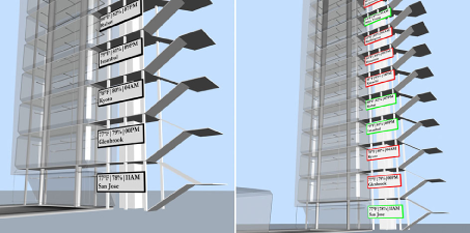
fabric | ch / Atmospheric Relations / 2008
Fritz Haeg of Fritz Haeg Studio gave an overview of his landscape architecture, and park and garden design. Haeg highlighted his Gardenlab project and positioned garden design as a "counterpoint to the spectacle of architecture". Over the last several years Haeg has produced a series of Edible Estates that reconsider "green" space in both public and private contexts. Thus far eight prototype gardens have been developed in cities including Salina, Kansas, Los Angeles and London (as part of the Tate Modern's Global Cities exhibit in 2007).
Patrick Keller of fabric | ch delivered a fascinating presentation on their work in developing and considering micro-climates. Fabric | ch describes itself as an "architecture, interaction & research" based practice and browsing their portfolio reveals some very exciting thinking (I'm definitely going to investigate and post about one of their earlier projects in the coming weeks). Keller discussed design projects such as their "informatic facade" for Atmospheric Relations and the interface for Philippe Rahm's Météorologie d'intérieur which was exhibited at the Canadian Centre for Architecture in 2006. A large portion of the presentation revolved around Real Rooms, a 2005 proposal that breaks down climates into discrete, modular units that play out across a larger "programmable" complex. Fabric | ch is an edgy, precise practice experimenting on archi-fundamentals (time, space) with very sophisticated considerations of the environment and information systems - exciting stuff! [See Dan Hill's detailed summary of this presentation]
Next up was Yo-Ichiro Hakomori of wHY Architecture who was interviewed by David Basulto and David Assael. This meandering conversation touched on a number of projects by the firm including the Grand Rapids Arts Museum and an Art Bridge. The latter project is an infrastructural intervention that provides pedestrian movement across the L.A. River while framing views of the water below and an expansive public mural. Midway through the discussion Hakomori mentioned that he considered Louis Kahn's Salk Institute one of his favourite project and this makes sense as wHY Architecture has developed a similar restrained monumentality.
The next session featured Dwayne Oyler and Jenny Wu of Oyler Collaborative, also fielding questions from Basulto and Assael. This experimental practice has executed some stunning installation work and the studio was commissioned by Ai Wei Wei to produce a residence as part of the Ordos 100 Villa project. As evidenced by projects like their 2008 Live Wire exhibit at SCI-Arc, it wasn't too surprising to learn that Oyler has collaborated with Lebbeus Woods in the past.
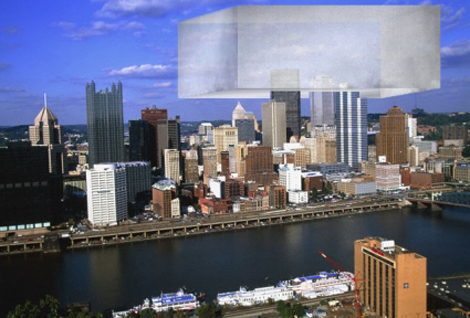
Daivd Gissen / Reconstruction - Smoke / 2006
Mary-Ann Ray of StudioWorks kicked off the second day of talks with a presentation on Chinese urbanism entitled "Towards Ruralpolitanism". Ray is working on an illustrated lexicon that indexes the intersection of massive Chinese cities with villages as there is no North American or European point of reference for understanding how cities and villages engage and interpenetrate one another in China. This research also extended into the cultural realm as Ray discussed a variety of principles pertaining to land ownership and management that roughly translated as "stir fried land" or "illegal mess" - she's trying to catalog these phenomena and engage them critically. Since there is no "suburbia" in Urban China, how do rural and urban systems respond to industrialism and agriculture? How does the population float back and forth between these urban typologies?
The next presenter was David Gissen of the excellent HTC Experiments blog. A historian and theorist at the California College of the Arts, Gissen expressed frustration with the gap between theory and and the practice of everyday life. He highlighted work such as Michael Caratzas' proposed preservation of the Cross-Bronx Expressways as being emblematic of ways that architectural historians might more directly engage the systemic nature of the city rather than just cordoning off specific buildings. Urban Ice Core - Indoor Air Archive, 2003-2008 is a "fantasy archive" in which Gissen proposed to collect and store indoor air for future analysis. Gissen closed his presentation with an utterly fascinating anecdote about his neighbour's parrot, and how it functioned as a mimetic device and imitated the ambient soundscape of the city - perhaps historians need to operate in a similar manner?
Robert Miles Kemp of Variate Labs presented a stellar body of work that blurred the lines between interface design, robotics and architecture. Kemp highlighted the impending fusion of physical and informational systems and identified an interest in thinking of software as "artifact" rather than control and robots as "systems" rather than anthropomorphic entities. Kemp showed a flurry of interfaces, dashboards and a homebrew multitouch display but what struck me the most was his 2006 thesis project Meta-morphic Architecture which proposed not just parametric design, but parametric space. Kemp maintains a research blog Spatial Robots - interactive systems fans take note.
Next up was an overview of Polar Intertia, the self described "journal of nomadic and popular culture" as edited by Ted Kane. Los Angeles is an idiosyncratic city full of storefront churches, mobile taco trucks, cell towers masquerading as palm trees and the like. Rather than homogenize discourse about the city (and urbanism in general) Kane parses the logic of these networks and phenomena. He presented an exciting overview of the politics of RV parked residences in Santa Monica and Venice and detailed how local legislation was creating a migrant population within these municipalities. Kane's journal looks quite exciting and I look forward to digging into it further.
The final presentation on Tuesday was Stephanie Smith of Ecoshack. Smith presented Wanna Start a Commune? which, by my reading, applies a veneer of revolutionary thinking and social activism from the 1960s (she identified The Diggers as a key influence) on top of a generic technology startup. The project aspires to monetize the toolkit required for microcommunity building, but I couldn't get past Smith's marketing rhetoric and ascertain a tangible position on what community was, let alone any kind of political stance. I wasn't at all surprised to learn she studied under Rem Koolhaas but her take on the intersection of capital, space and utopia seemed more crass than nuanced.
Stay tuned for my notes on the second half of Postpolis! LA. I'm also planning to provide some commentary on the organization and context of the event in relation to online media.
Monday, April 06. 2009
Via City of Sound
-----
By Dan Hill
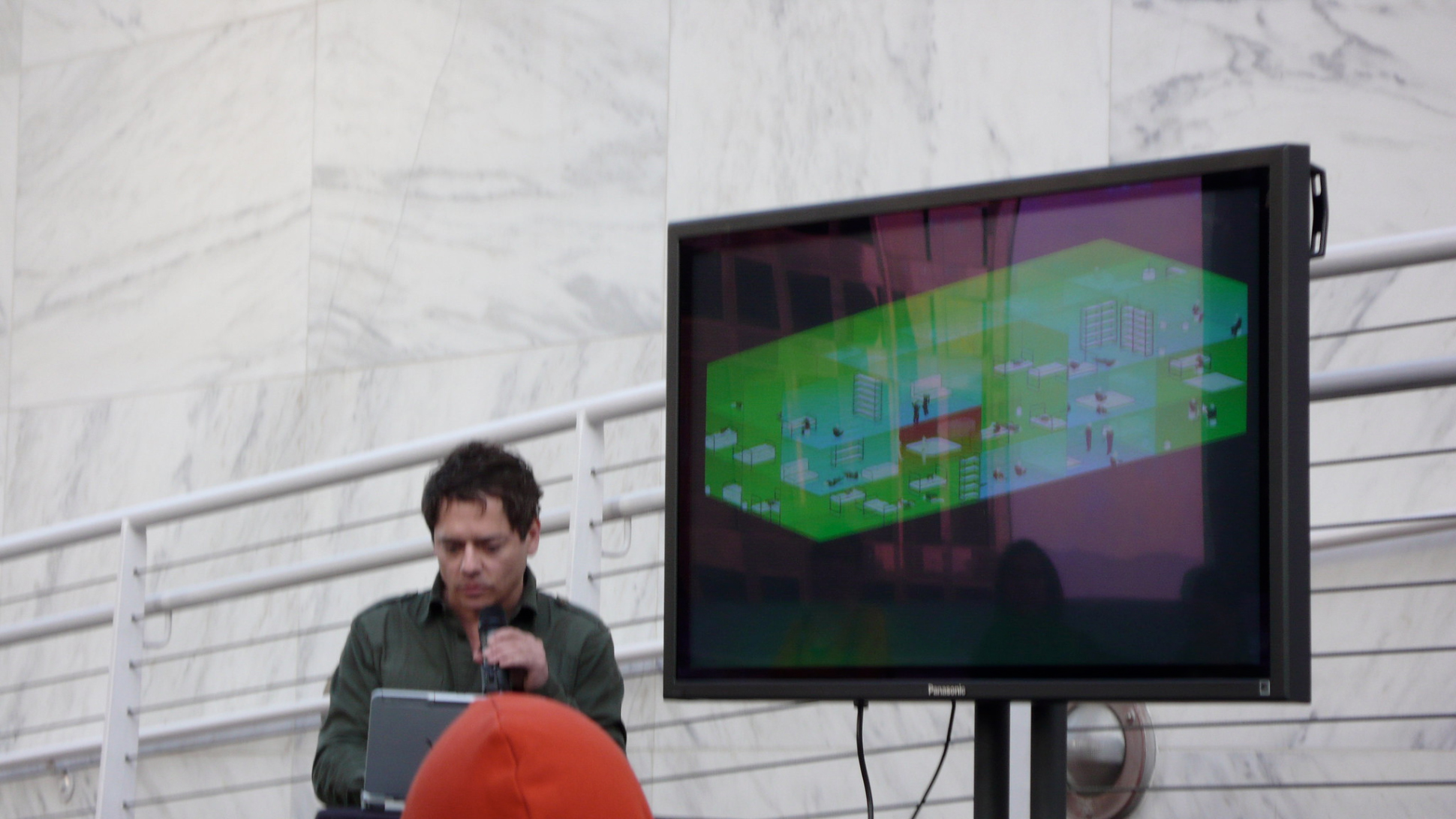
Patrick Keller’s talk was so up my strasse it’s ridiculous. Keller is from the Swiss architecture practice Fabric, originally from Geneva and now in Lausanne (I’m not sure why he was in LA.) He’s interested in the collaboration between information designers and architect, and works in the space between these disciplines, interested in creating responsive architectures (As am I.) He notes wryly that most of his projects are as yet un-built, “like most architecture”. (As are mine.)
He runs through a few projects in quick succession, each a progression of the other. There’s a lot more to his projects than we were able to get through in 30 minutes. All concern the interplay between the environmental characteristics of spaces, in terms of the idea of conditioned environments (somewhat apposite, given Banham’s ideas of Architecture of the Well-Tempered Environment (see my own spin on that) and as LA must be home to as much air conditioning as anywhere.)
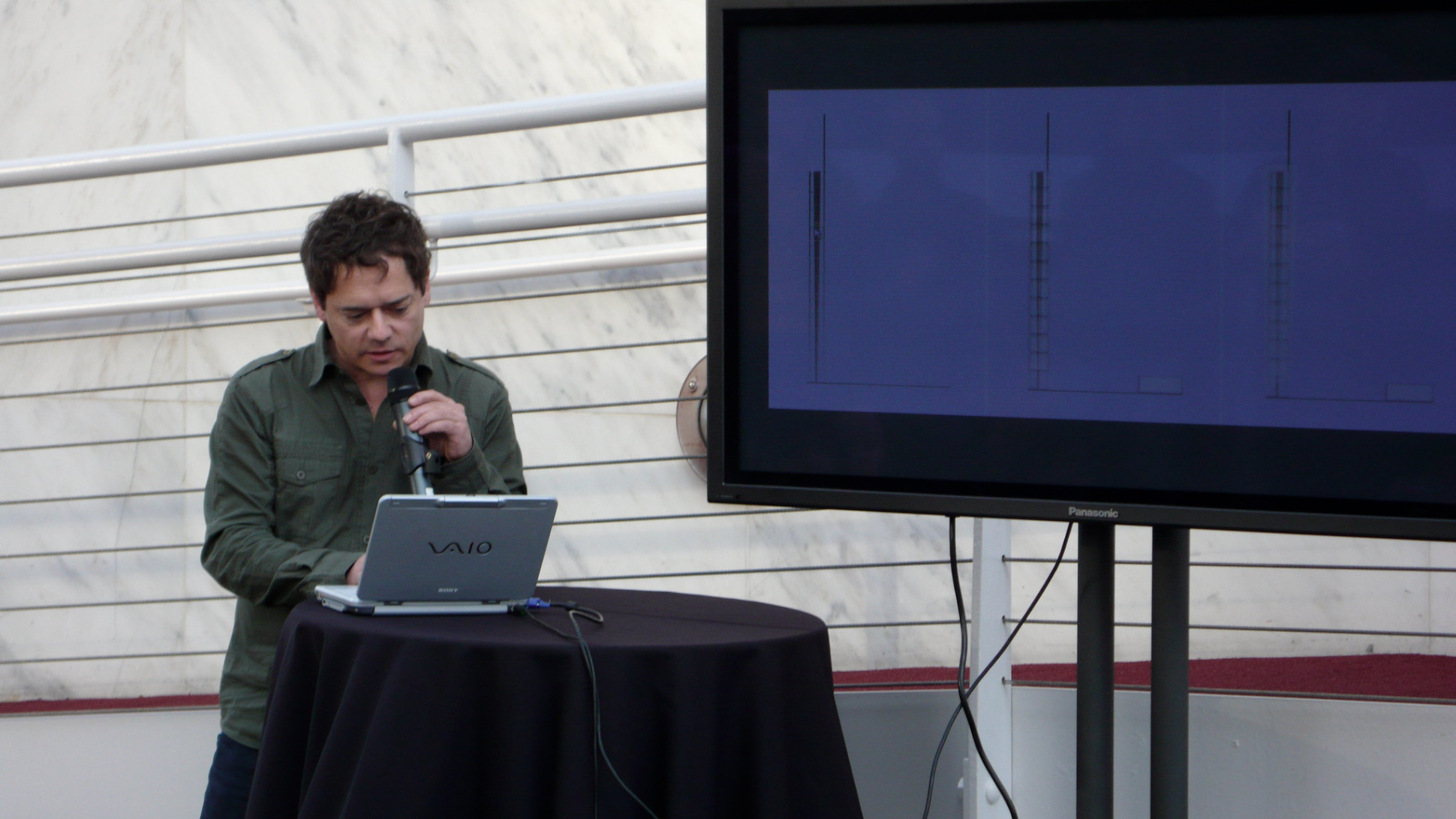
The first project is from a few years back as evidenced by the title. ‘Real Rooms’ (2005) takes its name from Real Player, then one of the de rigeur streaming media players. The idea being that instead of streaming media you could stream actual environments into spaces. This project, for Swiss giant Néstle, was situated in the world HQ of Néstle, a late-modern building with large areas of transparent glass on the outside but an almost hermetically sealed series of interior spaces (corridors, offices, cubicles, boxes etc.) which had precisely controlled environments in terms of internal artificial climates, artificial lighting etc.
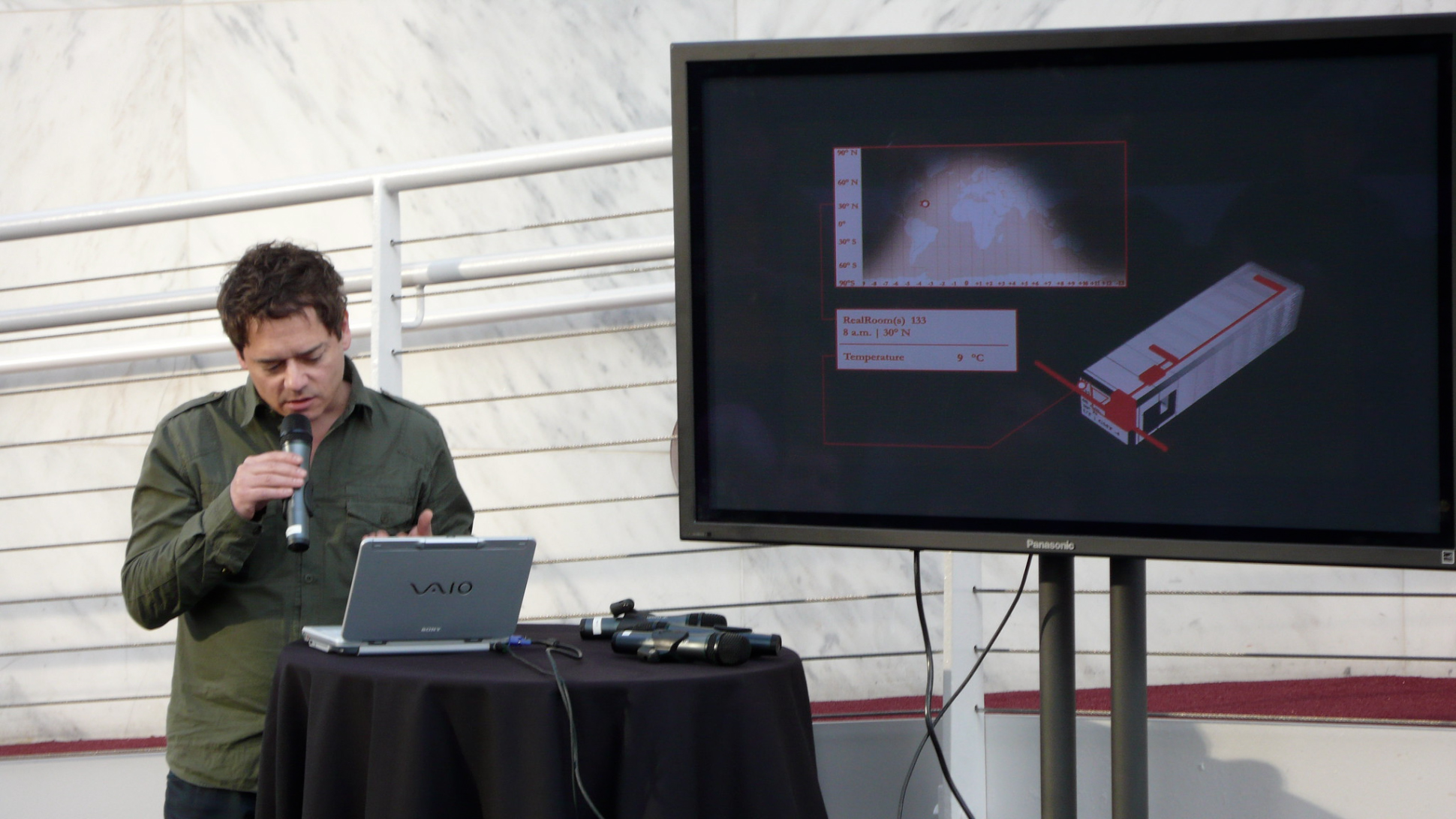

So given the building had lost a relationship with climate, at least on the interior, Fabric proposed a series of container-like interior ‘boxes’ which could be altered in terms of temperature and lighting to ‘stream’ artificial climates into those spaces, representative of climates and time zones from across the world (playing up Néstle’s global reach, perhaps) - that you could “invite a climate into the box” in Keller’s words. So you could make one environment always 8am, staying on the same latitude. Some could be “always dark, some always daytime - some very cold and some very hot”.


The building looked particularly beautiful at night, when only some part of it is lit, forming the shape of daylight across the globe. This shape would then change slightly varying with season.

The second project Keller showed also concerns internal atmospheres, but instead of controlling, this is about “letting climate go by itself”. A competition entry for a tower in San Jose, containing a huge volume of air. This building would also communicates climate around the globe, but using the natural processes of convection, albedo effect and so on within the volume of air. As opposed to the former project, this would just enable a climate within the structure, articulated by the volume of air, and then communicate the performance of that air volume via boxes with sensors on the exterior, linking it to climates worldwide.
The tower enables a kind of “porosity in vertical axis” so the air can ascend or descend, but with no porosity on the sides, it is trapped, in order to manifest the daily patterns within that volume.

Keller says it’s a sort of test tube environment for climatic variation: “In the morning you’d have cold air at bottom and warmer air at the top remaining from the day before … During the day, it gets warmer, and goes to the top, then cooler air is present at the bottom. Humidity collects at the top, condensates on the facade and runs down. Pollution particles are more dense at the bottom than at the top (as they’re heavier)”. And so on …

So the form triggers a natural atmospheric variation into building, which is then captured by the sensors. These sensors then feed information displays on part of building (essentially on each floor), enabling a comparison at each moment of the performance of the building itself, and then “related atmospheres” to other places on the globe. (A fascinating idea, and really close to my own ideas of building as urban dashboard.)

The third and final project was ‘Environ(ne)ment’ for the CCA, working with Philippe Rahm. This was both a form of “test environment and representation“ concerning an ‘artificial sun’ (as per Eliasson's Weather Project?) triggering differences in heat, light etc. within the gallery space. These phenomena then sampled by sensors, and feed projections about what’s going on in the space. Moving the ideas forward, Keller described how this exhibit then offered suggestions about how you could inhabit these spaces with differing climates - “propositions generated through software”, such as cooking on floor, sleeping on carpet, wearing clothes or not, furniture, activity and relationships all changing function in response to the different environmental characteristics. (This is an intriguing step forward for the ideas, moving into behavioural relationships as a result of changing environments quite directly, rather than the previous two projects with their more subtle but potentially ignorable approach of prompting.)
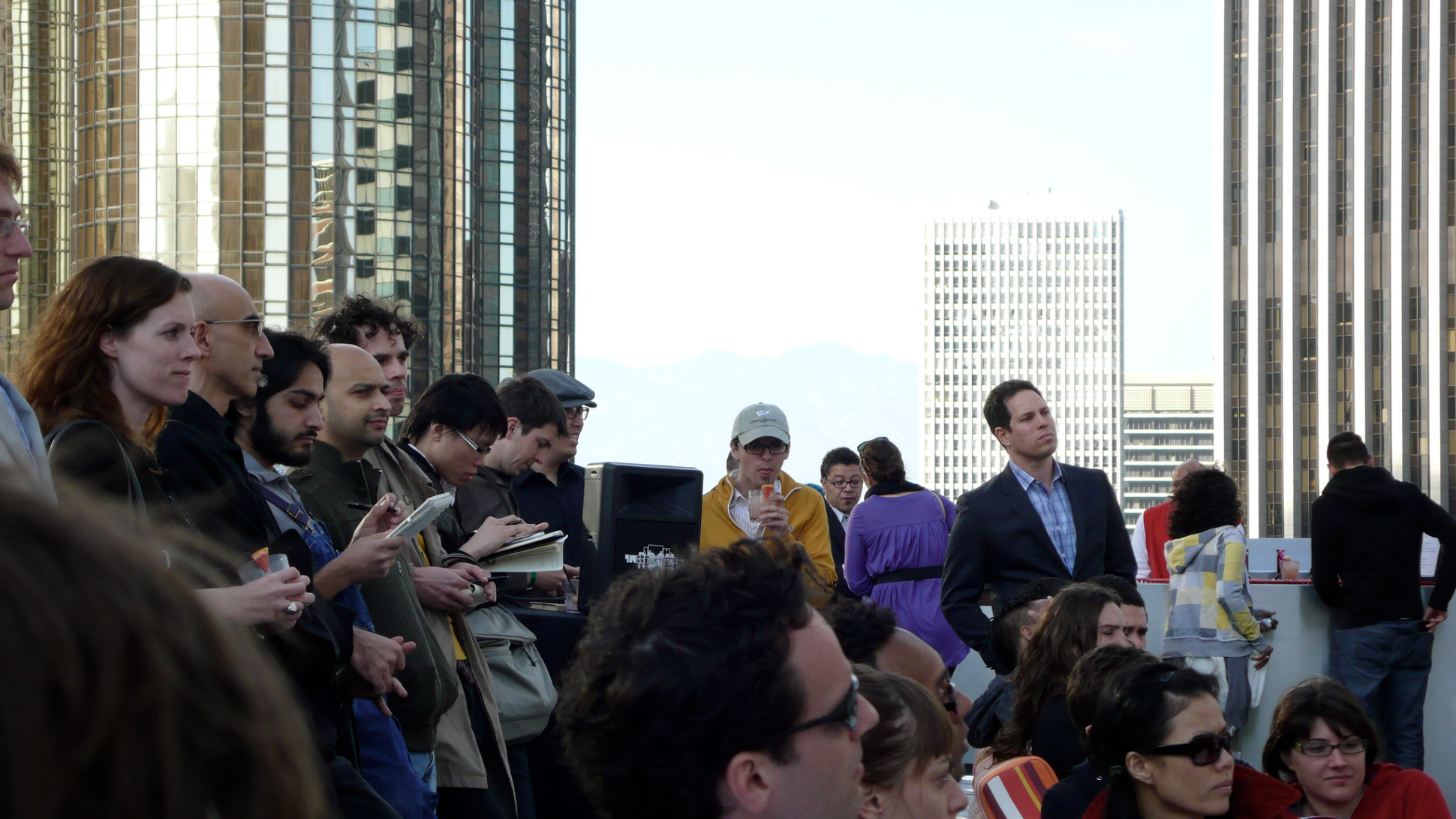
So Keller sums up by noting how the first project concerned a “conditioned environment” which is then questioned and reopened. The second was a “let go” environment, which is “more natural and costs nothing to trigger variation”. The third concerns “some new way of inhabiting those climates”. He believes this third is interesting as neither totally conditioned nor totally free, but somewhere in between …
Geoff asks a question concerning moving beyond the building into urban and landscape design through temperature gradients. “Could you engineer microclimates through LA? Could you bring different climates to the city?”
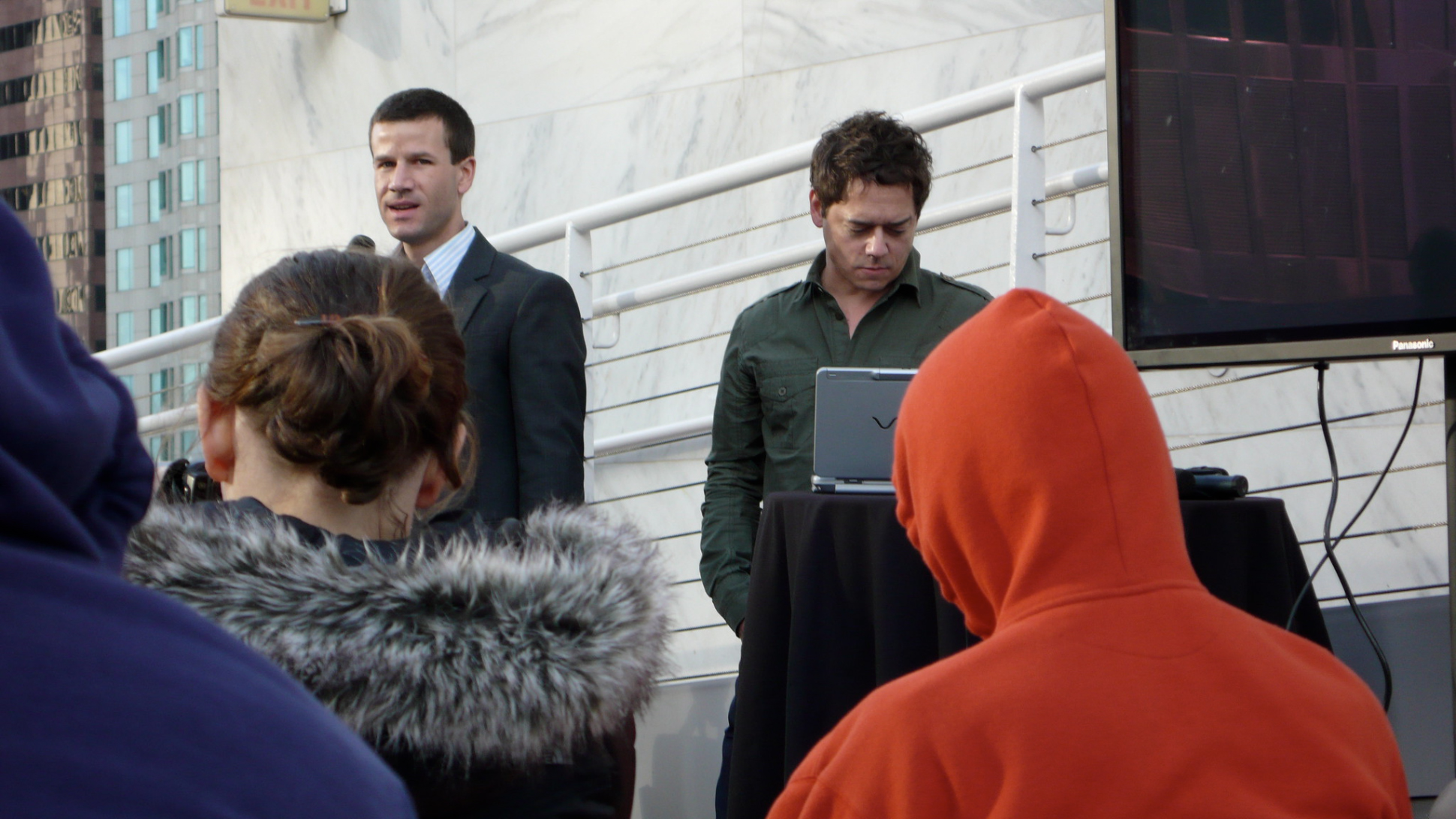
Keller responds that it could theoretically “go large scale, though it is hard to trigger it at this scale. At urban scale you have to deal with natural conditions as well”. Having said that, in a sense the cities have already changed our climate at this planetary scale of course - and we could do so again, he suggests, say by “painting the cities all white and replace polar caps” accordingly.
(There are many more fascinating projects at Fabric’s website, as well as details of the projects noted above, and it’ll be worth watching the work of this practice. This kind of work is at the most interesting junction with architecture and urbanism, to my mind, and perhaps the most potentially fruitful.)
Fabric.ch
Personal comment:
This was a really great and challenging event with sharp interventions. I hope we'll be able to organize one in Europe sooner or later (but rather sooner).
Thursday, April 02. 2009
-----
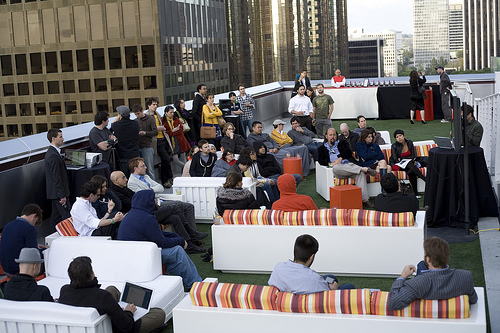
Photo by StoreFront Gallery, via Flickr
Well, this has been one of the most intense weeks I´ve had in quite so time. Postopolis! LA has turned to be an amazing event: An incredible venue at the rooftop of The Standard Hotel in downtown, a very interesting group of speakers, very proactive attendants, networking and drinks. And of course, the presence of our friends from BLDGBLOG (Geoff), City of Sound (Dan), Subtopia (Bryan), Mudd Up! (Jayce, a.k.a. dj/Rupture), We Make Money Not Art (Regina), The Storefront Gallery (Joseph, Cesar) and ForYouArt (Bettina, Devin).
During these days we had the chance to conduct live interviews with wHY Architectura (Yo Hakomori), Oyler Wu Collective (Dwayne Oyler, Jenny Wu), Sander Architects (Whitney Sander) and JohnstonMarkLee (Sharon Johnston, Mark Lee). These have turned to be very interesting, as you saw on the live streaming. Also, the audience has been participating making questions to the architects. And i have good news for this, as we got a new microphone and the audio recording is great! So expect the edited interviews to be posted soon.
Today we are going to interview Austin Kelly from XTEN Architecture, so if you´ve got any questions write a comment and i´ll try to get him to answer them. You can see the interview via Ustream at 5PM Pacific time.
As for the rest of the speakers, I´ve been impressed for the variety of architecture related topics discussed… urbanism, communes, sustainability… i really liked the presentations by Jeffrey Inaba (Inaba Projects), Patrick Keller (Fabric) and Stephanie Smith (Ecoshack, check her awesome project Wanna Start a Commune?). And there´s more to come, so be sure to check the full schedule. The quality of the Ustream feed is very good, so be sure to check it out.
Be sure to follow @Postopolis on Twitter (and also @archdaily) for live updates. There´s also a Flickr group, with very good photos.
We thank the StoreFront Gallery, ForYourArt and The Standard Hotel LA for making this event possible, one of the best by far.
And please remember that we have a closing party on Saturday!
Wednesday, April 01. 2009
Via WMMNA
-----
The first day of Postopolis is over. It went way better than i expected (and expectations were high.) We are on the rooftop of The Standard hotel which means looking at each other with a smug smile on our face that says "we're so lucky to be here". Problem is that the smile literally freezes as soon as the sun goes down: it gets cold beyond my worst nightmare of a night sleeping rough in Tobolsk (only slightly kidding here.) Bring your blanket and moon boots tonight or follow us on the webcast! Don't expect full reports as days are pretty busy but here are a few highlights of Day One on Postopolis planet:
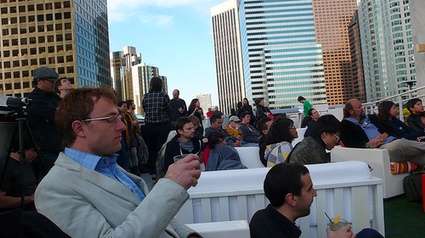
I had the immense pleasure of kicking off the series of talks by introducing Fritz Haeg (how can anyone be both laid-back and so stylish?) whom i had invited precisely for his dedication to engage with everything but architecture. You might remember that i had interviewed him briefly two years ago about Edible Estates, a project that challenges the lawn, this "carpet of conformity", by inviting families to replace their front lawn with food-producing vegetable gardens. Fritz discussed Edible Estates (look out for his next garden in New York in June), gave an overview of the performances and various education activities he organizes but he also explained us briefly another of his projects: Animal Estates.

Launched at the 2008 Whitney Biennial, the project that attempts to integrate animals in our landscape, in particular indigenous species that have disappeared because of human habitats and settlements. The customized dwellings are designed to encourage the resettlement of wildlife in urban neighbourhoods.
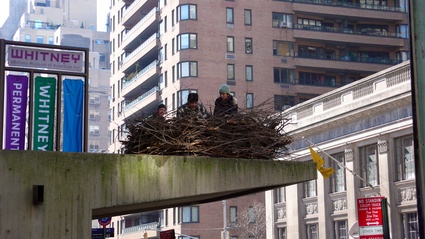
Next came a presentation of the work of experimental architecture group fabric by Patrick Keller who proved once again that Swiss architecture rocks (check out this other talk by his colleague Christophe Guignard) and a live interview of Yo-Ichiro Hakomori of wHY Architecture by the two David from ArchDaily & Plataforma Arquitectura. Been very impressed by the thought-provoking and quiet answers of the Americano-Japanese architect and blown away by the picture of one of the most striking building he designed: Royal/T, LA's first Japanese-style cosplay café.
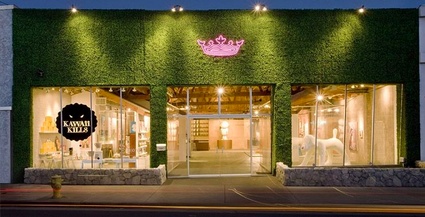
Bryan from Subtopia had had the great idea to invite Michael Dear Professor of Geography, USC and author of the book Postborder City (must get my hands on that one asap). A few noteworthy observation Dear made: the future of the city is already at work in L.A., there is no urban center, just a big sprawl and several urban centers here and there, the population is in majority latino; even if the U.S. managed to close their borders, the latininization of the country would still be unstoppable because of natural birth; diversity is the strongest feature of this society and we should embrace it instead of looking for questionable ways to avoid it; the border is everywhere we go, that's the frontera portatil, the border to go, etc.
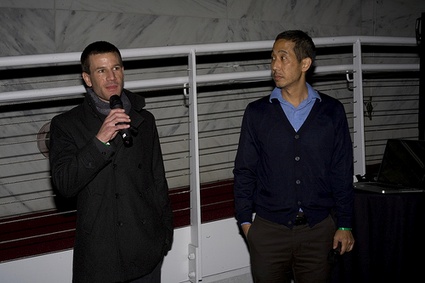
Geoff presenting Jeffrey Inaba (photo Storefront)
Geoff Manaugh invited Jeffrey Inaba who commented the shift architects must face because of the current crisis: going from private commissions to public ones, accepting a part of blame for the ambitions of their previous clients and reassessing the actions and strategies to undertake in this new climate. Sounds heavy? The talk was actually very witty, not particularly on the optimistic side but still energizing and sprinkled with ironic observations that went from gums on the pavement to extreme temperatures in Kazakhstan.
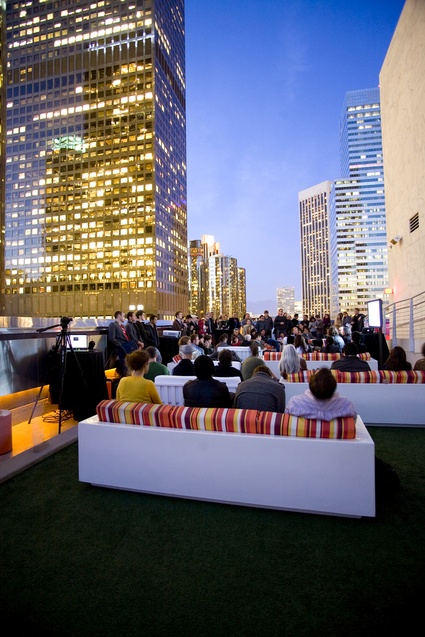
Image Storefront
Image on homepage: Postopolis flickr set by Storefront for art and architecture.
Wednesday, March 25. 2009
Via BLDBLOG and Storefront for Art and Architecture
-----
Postopolis! LA has been gathering pace over the past few weeks, despite the silence, so it seemed like high time for an update. Although we're still finalizing both the schedule and the list of speakers, it's looking amazing so far.
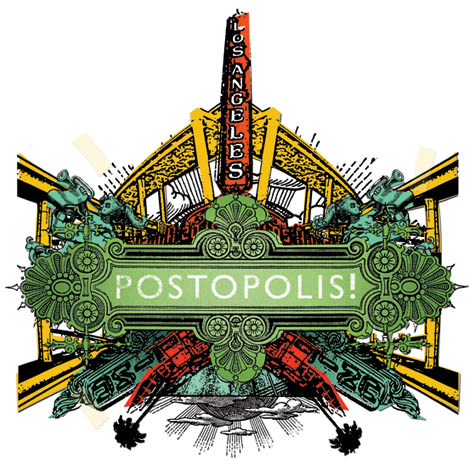 [Image: Logo by Joe Alterio]. [Image: Logo by Joe Alterio].
The whole thing kicks off in less than two weeks, running from Tuesday, March 31, to Saturday, April 4, and from 5pm-11pm everyday.
The venue has finally been announced, as well: we'll be up in the sky, watching the sun set every evening from the rooftop pool, deck, and bar of the Standard Hotel in downtown Los Angeles. The event is free and open to everyone, with a cash bar and free wifi, so come on down for some landscape and architecture, bring your favorite wireless device, and wear your Speedo or bikini if you want to use the pool (it's more like a wading pool, FYI). And, of course, we'll be keeping our fingers crossed for no rain.
The list of speakers, as it now stands, includes unbelievably interesting people. Here's a glimpse:
—Ari Kletzky (Founder, Islands of LA)
—Austin Kelly (Principal, XTEN Architecture)
—Ava Bromberg (Artist, In the Field)
—Ben Cerveny (Strategic and Conceptual Advisor, Stamen Design)
—Benjamin Ball and Gaston Nogues (Architects and Founding Partners, Ball-Nogues Studio)
—Benjamin Bratton (Architect and Theorist)
—Bryan Boyer (Organizer, Helsinki Design Lab 2010)
—Christina Ulke (Artist, Co-Founder, C-Level, and Editor, Journal of Aesthetics and Protest)
—Christopher Hawthorne (Architecture Critic, Los Angeles Times)
—David Burns, Matias Viegener, and Austin Young (Founders, fallen fruit)
—David Gissen (Theorist and Historian, CCA)
—Dwayne Oyler (Architect and Principal, Oyler Wu Collaborative)
—Eric Rodenbeck (Founder, Stamen Design)
—Freya Bardell and Brian Howe (Principals, Greenmeme)
—Fritz Haeg (Artist and Writer)
—Gary Dauphin (Writer and Critic)
—Jeffrey Inaba (Architect and Principal, Inaba Projects)
—Ken Ehrlich (Artist and Writer)
—Mary-Ann Ray (Architect, Writer, and Principal, Studio Works Architects)
—Matthew Coolidge (Director, Center for Land Use Interpretation)
—Michael Dear (Professor of Geography, USC)
—Michael Downing (Deputy Chief of Counter Terrorism, Los Angeles Police Department)
—Mike the Poet (Poet and Writer)
—Orhan Ayyüce (Architect, Blogger, and Senior Editor, Archinect)
—Patrick Keller (Architect and Principal, Fabric)
—Paul Petrunia (Founder, Archinect)
—Robert Miles Kemp (Designer and Principal, Variate Labs)
—Sam Grawe (Editor-in-Chief, Dwell)
—Sharon Johnston and Mark Lee (Architects and Principals, Johnston MarkLee)
—Stephanie Smith (Founder, Ecoshack)
—Steve Roden (Musician and Artist)
—Ted Kane (Architect and Author, Polar Inertia)
—Whitney Sander (Architect and Principal, Sander Architects)
—Yo-Ichiro Hakomori (Architect and Principal, wHY Architecture)
—Zach Frechette (Editor-in-Chief, GOOD)
That's nowhere near the final list, though, as we've also got a handful of media panels planned for Saturday, April 4; these will include Matt Chaban from the Architect's Newspaper, Dakota Smith from Curbed LA, Greg J. Smith of Serial Consign & Vague Terrain, journalist Alissa Walker, a variety of Archinect school bloggers, and many, many more.
So stay tuned for more updates.
And, don't forget, Postopolis! LA will be hosted by BLDGBLOG, City of Sound, mudd up!, Plataforma Arquitectura/Arch Daily, Subtopia, and we make money not art, under the organization of the Storefront for Art and Architecture and the sponsorship of ForYourArt.
Hope to see you there!
Personal comment:
Names (including fabric | ch) at Postopolis!LA.
Thursday, February 08. 2007
 Lift07 day two is long and extremely stimulating. There are just too many great talks by super smart people. If you'd like to follow what's going on at Lift in french, le team de InternetActu is blogging the event en français. Christophe Guignard, one of the founding members of fabric | ch, an architecture studio based in Lausanne, Switzerland, gave one of the talks that interested me most. Titled Architectural Contemporary Space(s), it was an introduction from an architectural point of view on how space is transformed by technology and other processes. Lift07 day two is long and extremely stimulating. There are just too many great talks by super smart people. If you'd like to follow what's going on at Lift in french, le team de InternetActu is blogging the event en français. Christophe Guignard, one of the founding members of fabric | ch, an architecture studio based in Lausanne, Switzerland, gave one of the talks that interested me most. Titled Architectural Contemporary Space(s), it was an introduction from an architectural point of view on how space is transformed by technology and other processes.
He illustrated the point very simply with a picture he had taken on holiday. On the same image there was the Parthenon, traces of airplanes passing through the sky, people taking pictures or fiddling with their mobile phone. The ancient Greek built temples for gods that reproduced the laws and proportions that rule the cosmos at human scale. But today the relationship between architecture and space is much more complex. New situtations and elements emerge that lead to new architectural situations and possibilities: mobility, networked communities, understanding of Earth as a unique space, 24/7 working time, etc.
Below some emblematic images that embody this idea: ski slopes in Dubai, flight simulation, the electro-magnetic spectrum, people writing messages on the surface of the Earth to be seen by satellites, simulation of weather, etc.
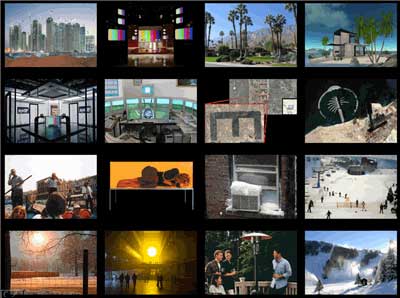
These systems are not independent from one another, they overlap and interfere. They also demonstrate that our environment is not static anymore, it's going beyond the dimension, it's giving life to what Christophe Guignard calls an "ex-dimension" architecture.
Le Corbusier defined architecture as a playful game of volumes under the visible light. Now architecture is much wider than that. There's no truth anymore about architecture but some fictions.
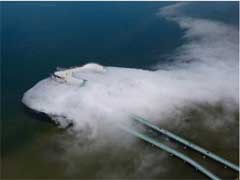 A few examples: A few examples:
The Blur building by Diller & Scofidio, Swiss national expo 2002, Yverdon-les-bains, Switzerland. Architecture of water and humidity.
Philippe Rahm's Hormonorium was based on the idea that understanding the physicochemical mechanisms that govern organisms brings about a change in how we understand space, and thus in the way we inhabit the environment.
The Hormonorium featured an alpine-like climate, and thus its light is much brighter and it contains less oxygen, just like when you're at altitudes of about 3000 meters. The floor is made of 528 fluorescent tubes, which emit a white light that reproduces the solar spectrum, with UV-A and UV-B. This very bright light of between 5,000 and 10,000 lux stimulates the retina, which transmits information to the pineal gland that causes a decrease in melatonin secretion. Visitors were thus supposed to experience a decrease in fatigue, a probable increase in sexual desire, and regulation of moods. Besides, the oxygen-rarefied space caused a slight euphoria due to endorphin production.
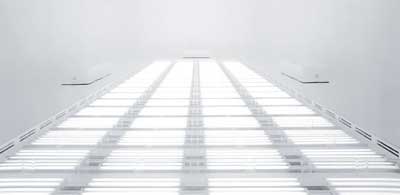
Hormonarium and the body reactions it created show that architecture is more than what the eye perceives.
Christophe then gave an overview of a few projects developed at his architecture and research studio, fabric | ch:
- Real Rooms, peripheral architecture for the Nestlé World Headquarters in Vevey (near Geneva). This concept aimed at reflecting the fact that Nestlé is a company that works 24/7 on 5 continents, that continuously exchanges data and goods, its workspace is global. Like any big company his administrative building are regulated by air co in order to get what is regarded as a "comfort of space." The RealRoom(s), informed by atomic clocks, luminosity, heat, pressure and humidity sensors, are distributed across a space representing the entire globe (one RealRoom per time zone, on 0°, +/-30°, +/-60° and +/-90° latitude). These RealRoom(s), connected permanently, directly recreate in an artificial but perceptible way, a global "terrestrial spatiality" fitting to the scale of Nestlé in 2005.
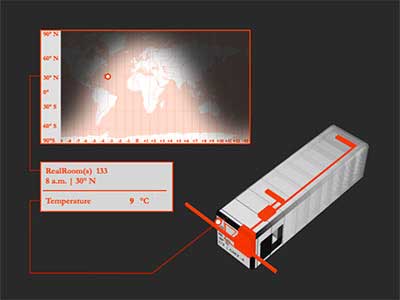
One of their latest projects, Perpetual (Tropical) Sunshine, was reproducing the heat and light of the sun from the Tropic of the Capricorn into Northern atmospheres. The work plays with space, timezones and climate, but also with the interface between global and local, reality and virtuality.
The system grabs information from weather stations and goes randomly to places where the sun is shining to produce a never-ending abstract summer. Fabric installed Perpetual (Tropical) Sunshine in several cities in the North of Europe. The screens of the installation are built with infra red bulbs so they actually heat the place. The screen are not merely visual, they are also sensorial.
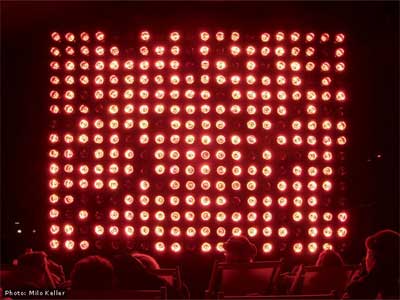
The most striking thing was to observe the way people were behaving in front of the installation, standing under the rain to watch the abstract sunshine.
These examples should open new ideas to create other fictional spaces.
PPS presentation of Christophe.
|





















 [Image: Logo by
[Image: Logo by 

 A few examples:
A few examples:


